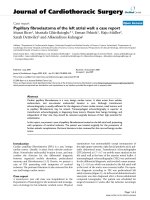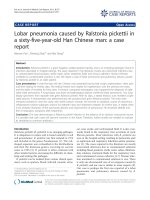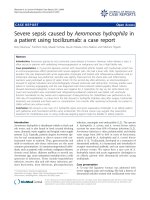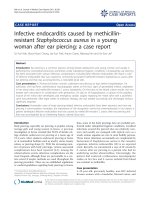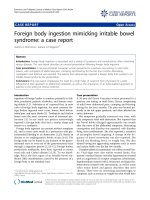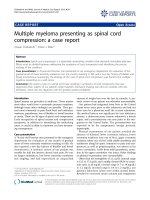Báo cáo y học: " Infective endocarditis caused by Staphylococcus aureus in a patient with atopic dermatitis: a case report" potx
Bạn đang xem bản rút gọn của tài liệu. Xem và tải ngay bản đầy đủ của tài liệu tại đây (307.69 KB, 3 trang )
BioMed Central
Page 1 of 3
(page number not for citation purposes)
Journal of Medical Case Reports
Open Access
Case report
Infective endocarditis caused by Staphylococcus aureus in a patient
with atopic dermatitis: a case report
Gadha Mohiyiddeen, Ian Brett and Edward Jude*
Address: Department of Medicine and Department of Radiology, Tameside General Hospital, Ashton-Under-Lyne, Lancashire OL6 9RW, UK
Email: Gadha Mohiyiddeen - ; Ian Brett - ; Edward Jude* -
* Corresponding author
Abstract
Introduction-: Atopic dermatitis (AD) is a common condition in the United Kingdom with the
prevalence varying from 21% in infants aged 0–6 months to 6.4% at the age of 16 years. Patients
with AD experience high rates of colonization of their skin surfaces by Staphylococcus aureus (S.
aureus). In severe AD there is a potential risk of staphylococcal bacteremia and invasive infection
such as acute endocarditis.
Case presentation-: We report a case of acute endocarditis with mitral valve destruction caused
by S. aureus in a 30-year-old man with severe AD. The patient received intensive inpatient
treatment with antibiotics and underwent successful mitral valve replacement and skin treatment
for AD.
Conclusion-: Patients with severe AD are at higher risk of staphylococcal bacteremia and
endocarditis. Staphylococcal endocarditis has to be considered in the differential diagnosis of febrile
illness in patients with uncontrolled atopic dermatitis.
Introduction
AD is a common skin disorder where there is excessive for-
mation of IgE antibodies to inhaled, injected or ingested
allergen. The cardinal feature of AD is itch, and scratching
may account for most of the signs. Colonization of S.
aureus is commonly observed in skin lesions of atopic
dermatitis patients, and scratching of the pruritic lesions
may lead to reiterative bacteremia and endocarditis. S.
aureus typically causes acute endocarditis with damage to
cardiac valves, embolisation of vegetation to extracardiac
sites and progresses to death within weeks if left
untreated. There has been rising awareness in the medical
literature about the potential risk of staphylococcal endo-
carditis in young patients with AD. Although the inci-
dence of endocarditis in atopic dermatitis is rare, this
needs to be recognized as one possible complication in
this common skin disorder.
Case presentation
A 30-year-old man with history of AD presented to the
accident and emergency department of our hospital with
fever and generalized skin rash. He complained of malaise
and poor appetite for a week. He had a brief period of con-
fusion on the day prior to admission. He also suffered
from bronchial asthma that was well controlled with
bronchodilator inhalers. There was no previous history of
heart disease or rheumatic fever. He worked as an engi-
neer in a plastic factory. He denied smoking or intrave-
nous drug use. He had extremely dry skin with
lichenifications affecting almost all areas of his body but
worse on the elbows and knees for which he was applying
Published: 4 May 2008
Journal of Medical Case Reports 2008, 2:143 doi:10.1186/1752-1947-2-143
Received: 10 March 2007
Accepted: 4 May 2008
This article is available from: />© 2008 Mohiyiddeen et al; licensee BioMed Central Ltd.
This is an Open Access article distributed under the terms of the Creative Commons Attribution License ( />),
which permits unrestricted use, distribution, and reproduction in any medium, provided the original work is properly cited.
Journal of Medical Case Reports 2008, 2:143 />Page 2 of 3
(page number not for citation purposes)
moisturizers and 1% hydrocortisone cream. The exacerba-
tions of eczema were treated with 2.5% hydrocortisone
cream and varying dose of prednisolone tablets.
On examination, the patient was drowsy; temperature was
38°C, pulse rate 110/min and blood pressure 144/88 mm
Hg. He had a generalized erythematous macular non-
blanching skin rash (Figure 1) and small purpuric haem-
orrhages over the palate. Systemic examination revealed a
pansystolic murmur in the mitral area, splenomegaly and
weakness of the right leg (power 3/5). Both plantar
reflexes were extensor and sustained ankle clonus was
present. There were no signs of meningeal irritation, cere-
bellar dysfunction or sensory deficit and fundoscopic
examination was normal.
Laboratory investigations revealed haemoglobin 15.7 g/
dl, WBC 14.5 × 10
9
/l, platelets 50 × 10
9
/l, ESR 19 mm/
hour, C-reactive protein 292.9 mg/l, serum sodium 128
mmol/l, serum potassium 3.3 mmol/l, bicarbonate 27
mmol/l, blood urea 7.5 mmol/l and serum creatinine 207
µmol/l (patient's baseline – 118 µmol/l). Urine dipstick
was positive for blood (++) and protein (+). Chest X-ray
was normal. 12 lead ECG showed sinus tachycardia with
features of left ventricular hypertrophy. Transthoracic
echocardiogram showed mitral valve vegetation with
severe mitral regurgitation and normal ejection fraction.
CT scan of the brain was normal but MRI identified mul-
tiple areas of white matter abnormality suggestive of
embolism around the periventricular area. Two sets of
blood cultures grew Staphylococcus aureus sensitive to
gentamicin and flucloxacillin.
The patient was commenced on intravenous gentamicin
and flucloxacillin and later teicoplanin. After 48 hours he
became afebrile; the rashes started to fade and his right leg
weakness improved. CRP and ESR gradually reduced.
Three weeks later, he had a recurrence of fever with eleva-
tion of CRP and ESR. Blood culture at that time showed
no growth but his central venous line tip grew a coagulase-
negative staphylococcus sensitive to rifampicin, vancomy-
cin and netilmycin. His condition improved with removal
of the central line and addition of rifampicin. The treat-
ment was continued with teicoplanin for 6 weeks and
rifampicin for 4 weeks. He was discharged 5 weeks later
on treatment with ramipril and frusemide in view of sig-
nificant mitral regurgitation.
Three months later, he underwent transoesophageal
echocardiogram which showed perforation of the poste-
rior mitral cusp with significant mitral regurgitation (Fig-
ure 2). He underwent successful mitral valve replacement
5 months following the presenting episode of infective
endocarditis and was commenced on warfarin. Though he
had an episode of eczema herpeticum two years following
the infective endocarditis, he continues to do well.
Discussion
This case report lends support to the association of infec-
tive endocarditis due to S. aureus and AD. In native valve
endocarditis, S. aureus accounts for 30–35% of cases,
whereas in a patient with atopic dermatitis, it is found to
be exclusively due to S. aureus [1]. This could be the result
of frequent staphylococcal bacteremia in patients with
AD.
S. aureus is an aggressive pathogen and bacteremia with
this organism can infect healthy heart valves. Neurologi-
cal complications of infective endocarditis, particularly
embolic events, tend to be higher with this organism.
Preservation of the mitral valve is also rare when infection
is caused by S. aureus due to valvular damage and the
presence of huge mobile vegetations [2].
Erythematous macular non-blanching skin rashFigure 1
Erythematous macular non-blanching skin rash.
Publish with BioMed Central and every
scientist can read your work free of charge
"BioMed Central will be the most significant development for
disseminating the results of biomedical research in our lifetime."
Sir Paul Nurse, Cancer Research UK
Your research papers will be:
available free of charge to the entire biomedical community
peer reviewed and published immediately upon acceptance
cited in PubMed and archived on PubMed Central
yours — you keep the copyright
Submit your manuscript here:
/>BioMedcentral
Journal of Medical Case Reports 2008, 2:143 />Page 3 of 3
(page number not for citation purposes)
A study on the microbial flora of patients with AD
revealed carriage rates of S. aureus as 79% in the anterior
nares, 76% in the uninvolved normal skin and 93% in the
lesions. Thus S. aureus is the predominant organism in
the atopic lesions and constituted 91% of the total aerobic
bacterial flora. Coagulase-negative staphylococci are the
second predominant organisms (9%) isolated from the
skin lesions in AD. On normal skin, coagulase-negative
staphylococcus is found to be the predominant organism,
constituting 63% of the total flora, followed by S aureus,
constituting 30% of the bacterial flora [3].
There are several possible causes for the predominant col-
onization by S. aureus. One study suggested the cause
could be due to the lack of the innate immune system of
antimicrobial peptides known as cathelicidins (LL-37)
and beta-defensins (HBD-2) of the atopic skin. The com-
bination of LL-37 and beta-defensins (HBD-2) is shown
to have synergistic antimicrobial activity in the body for
effective killing of S. aureus. A deficiency in the expression
of antimicrobial peptides in these patients may account
for the susceptibility to skin infection with S. aureus [4].
Thus there is a potential risk of staphylococcal bacteremia
and acute native valve endocarditis in patients with
uncontrolled AD; the latter condition may be a risk factor
for the former [2,5]. While the true incidence of systemic
staphylococcal infections in AD is currently unknown, it is
conceivable that it may be more common than previously
thought.
Conclusion
High rate of cutaneous colonization by S. aureus in atopic
dermatitis lesions represents an important source of bac-
teremia and there is a possibility of bacteremia progress-
ing to invasive bacterial infection such as endocarditis.
Staphylococcal bacteremia has to be considered in the dif-
ferential diagnosis of fever in patients with severe AD [6].
Competing interests
The authors declare that they have no competing interests.
Authors' contributions
GM contributed to acquisition of data and drafting the
manuscript. IB revised critically for important intellectual
content. EJ gave final approval of the version to be pub-
lished. All authors read and approved the final manu-
script.
Consent
The authors declare that informed written consent was
obtained from the patient for the publication of this man-
uscript and the accompanying figures.
References
1. Eleftherios Mylonakis, Calderwood Stephen B: Review article on
Infective Endocarditis in Adults. N Engl J Med 2001,
345:1318-1330.
2. Harada M, Nishi Y, Tamura S, Iba Y, Abe K, Yanbe Y, Akimoto T,
Takao N, Watanabe S, Hayashida N, Koyanagi H: Infective endo-
carditis with a huge mitral vegetation related to atopic der-
matitis and high serum level of infection-related
antiphospholipid antibody. J Cardiol 2003, 42:135-40.
3. Aly R, Maibach HI, Shinefield HR: Microbial flora of atopic derma-
titis. Arch Dermatol 1977, 113:780-2.
4. Ong PY, Ohtake T, Brandt C, Strickland I, Boguniewicz M, Ganz T,
Gallo RL, Leung DY: Endogenous antimicrobial peptides and
skin infections in atopic dermatitis. N Engl J Med 2002,
347:1151-60.
5. Onoda K, Mizutan H, Komada T, Kanemitsu S, Shimono T, Shimpo H,
Yada I: Atopic dermatitis as a risk factor for acute native valve
endocarditis. Heart Valve Dis 2000, 9:469-71.
6. Hoeger Peter H, Rainer Ganschow, Gerlinde Finger: Staphylococ-
cal Septicemia in Children with Atopic Dermatitis. J Heart
Valve Dis 2000, 9:469-71.
Transoesophageal echocardiogram showing perforation of the posterior mitral cusp with significant mitral regurgitation (spontaneous echo contrast in left atrium)Figure 2
Transoesophageal echocardiogram showing perforation of
the posterior mitral cusp with significant mitral regurgitation
(spontaneous echo contrast in left atrium).


